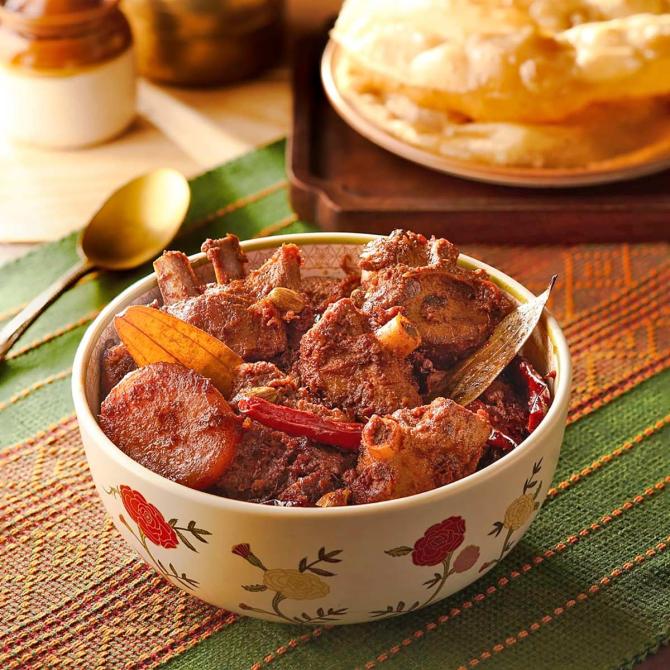
First some number crunching.
The number of Durga pujo pandals in Bengal: 40,000.
The number of Durga pujo pandals in Kolkata: 3,000.
For comparison, Mumbai has around 200-odd Durga pujo pandals.
Durga pujo is Bengal's biggest, spendiest, happiest, cultural and quasi-religious fiesta. Nothing, nowhere, compares to Durga pujo in Bengal. This is the time the kaash phool (wild sugarcane, remember that scene in Pather Panchali as the children scamper towards the train through the kaash phool) and shuili phool (night jasmine) embraces Ma Durga as she along with her children -- Lakshmi, Saraswati, Ganesh and Kartik -- come down from Mount Kailash to her mom's home.
Life comes to a halt before it -- anticipation -- and after it -- physical collapse.

The phantasmagoria behind Durga pujo pandals and the deity begin a year before pujo. So, the moment this pujo is over, ideation and planning for next year's begins. The artistry of Durga pujo pandals and the deity outside Kolkata is very poor, but be that as it may, what unites Durga pujo festivities everywhere is the sheer exuberance and joy of pandal-hoppers.
It's about being dressed to the nines, slurping a mutton shank, doing the dhunuchi dance, or simply an adda session in the pandal, lazily listening or watching the cultural splendour of drama-dance-music on stage.

Facebook recipe reels over the last few days have been popping up to remind me of 'vrat ka khana' (satwik vegetarian food without onion, garlic eaten by non-Bengalis at the time of Navratri).
Durga pujo pandal-hopping Instagram reels, on the other hand, show you around some of the magnificent pandals in Kolkata with the blogger/influencer then moving the camera away from Ma Durga's face to close-up of a chop, cutlet or Mutton Rezala at one of the 'must-eat' restaurants near that pandal.
This is because most Kolkata pandals do not have food stalls unlike the ones outside Kolkata. So, when you have begun pandal-hopping at 6 pm and ended at 6 am, you are bound to get hungry.
Outside Mumbai, all Durga pujo pandals have an entire section that has food stalls, handicraft and textile, jewellery, music and book stalls.
Pandal-hopping outside Kolkata, therefore is as much for the deity herself, as for the gastronomic smorgasbord. Bengali food, art and culture occupy primacy at the stalls, but when you're faced with so many choices, what do you eat and what do you skip? What is a Kobiraji Cutlet and what is a Mocha-r Chop.
This then, is the definitive guide to eating out at Durga pujo stalls.
1. Kathi Rolls/Egg/Chicken/Mutton Rolls
What Tibbs is to the Frankie, Nizam's is to the roll.
A Frankie is called a roll in Kolkata, and as far as I know, Tibbs doesn't have an outlet in Bengal -- they wouldn't sell ice to the Eskimo.
The kathi roll is called the roll in Bengal and is available in egg, chicken, mutton (pronounced 'mawtone' there) and vegetable (potatoes and/or paneer; haven't tried it, don't want to).
The roll is said to have been created at Nizam's, a small restaurant near the New Market area (which used to the White area during the British Raj) in Kolkata. The eatery is opposite the Kolkata Municipal Corporation Building and according to Google was founded by 'Raza Hassan Saheb and started as a kebab and paratha stall'.
But apparently demand outnumbered the seats at the eatery then, as it does now, and to keep pace with the orders from and the impatience of the sahebs, the iron skewers were replaced by bamboo ones (kathi or stick) to make it less unwieldy and the grilled meat was put into a paratha with raw onions and chillies, rolled up and sealed with paper. And so the paratha-mutton sit-down-meal metamorphosed into the roll -- a quick, hot, tasty meal -- which could be eaten on the go
There are probably as many roll shops in Kolkata as there are Batata Vada outlets in Mumbai and the egg roll is my go-to when I'm there, as it is, at a Durga pujo pandal in Mumbai.
The egg roll is like the Margarita Pizza -- it can't hide behind meat and masala -- and only when it passes muster -- do I try the mutton one from the same stall. Or move on.
Look for stalls that make the roll before you; make sure they add the powder masala, kashundi, extra chopped green chilies and you're good to go.

2. Mughlai Paratha
I had my first Mughlai Paratha with my dad at Anadi Cabin in Kolkata decades ago. Anadi Cabin is in the Esplanade area, again a formerly White area pre-Independence, and is a greasy spoon. The reason my dad took me there was because the eatery is believed to have invented the Mughlai Paratha in the 1920s.
As for why it's called a cabin is for another day, but suffice to say that most greasy spoons of the pre-Independence era are suffixed by 'cabin', though there aren't any cabins in the restaurant.
The Mughlai part of the paratha comes from its origins -- it was apparently invented by Mughal emperor Jehangir's cook who hailed from Burdwan in Bengal. But there are other stories, that date it to the Turk invasions before Mughal Emperor Babur had even sniffed out India. The Turkish have a similar egg-meat flat bread called the Gözleme, but history seems to have credited the Mughals for this paratha.
The Mughlai Paratha is similar to the Baida Roti that you get in Mumbai. It's a square paratha stuffed with egg, onion, green chillies and spices and served with Alu Tarkari (potato curry) or Chola-r Dal (chana dal) and a side of onion, cucumber, carrot, beetroot salad. The egg-keema version of the Mughlai paratha is served only with the salad.
The paratha is shallow fried actually, but in pujo pandals to ensure quick output, it's deep fried. Ask for the ones that have keema and egg and look for a stall that shallow fries the paratha. If the keema version is not available, ask them not to stint on the Alu Tarkari, generally excellent.
3. Kolkata Biryani
Let's not argue about which biryani is best. Copernicus and Galileo tried saying the Earth goes around the sun and we know how that went (disbelief and imprisonment).
But I do concede that Lucknow Biryani is actually as good as the Kolkata one and therein lies a tale.
The Kolkata Biryani, in fact, owes its origins to Wajid Ali Shah, Awadh's last Nawab, who the British dethroned and exiled in 1856 to Bengal. He was given land in Metiabruz, a Calcutta suburb. The nawab had. of course, brought his khansamas with him and the story goes that as a refugee in his own land, he was constrained to feed his entourage.
So, he added boiled eggs and potatoes to the biryani which would increase the yield and that, is how the Kolkata Biryani was born. The original Lucknow Biryani apparently did not have potatoes or eggs, but nowadays even the Hyderabadi Biryani bows to the potato.
If you like Hyderabadi Biryani avoid the Kolkata version. If Hyderabadi Biryani -- which is what you get in Mumbai -- is high on spices and has that thick glob of masala sitting under the rice, the Kolkata Biryani is as light as a pulao.
Pujo pandals generally don’t serve a good biryani but if you see the stall being manned by a Bengali restaurant that you recognise, go for it.
Ask for the egg and potato with the rice.
And yes, biryani is mutton. Not vegetable or chicken.
Photograph: Kind courtesy: Joseph Manavalan/Rediff.com
4. Luchi-Kosha Mangsho
Just to be clear -- luchi is not puri.
They look different, they taste different, they feel different.
Luchi is made entirely of maida with maybe a spoon of aatta, while puri is made entirely of aatta.
Luchi is white, puri is dark beige to brown.
Luchi absorbs less oil and doesn't turn into a frisbee when not eaten hot.
Luchi is thin and as soft as a downy pillow, puri is thick and hard and chewy.
Legend goes that the decadent, erstwhile zamindars of Bengal would tear off the delicate, translucent top layer of the luchi, the icing on the cake, and chuck the bottom. I tried it as a kid and got some love on my bottom.
Kosha Mangsho sits familiarly on non-Bengali palates nowadays, and if ever there was a marriage made in heaven, it is when luchi decided to wed Kosha Mangsho. It's a lifetime of happiness and cholesterol.
Kosha means bhuna or sautéed till your arms drop off.
It is NOT pressure-cooked and it is always mangsho (yes, you know what means... mutton!). The gravy is what Bengalis call 'makha-makha' or just enough to embrace the mutton without being runny.
Slow-cooked, dark, rich, bursting with flavour, Kosha Mangsho apparently owes its origins to a restaurant in north Kolkata's Shyambazar (the Black area during the Raj and the first settlements before Kolkata became a city). The restaurant, which is now a 100 years old, still serves its signature Kosha Mangsho.
Ask the pujo pandal stall to give you a 'good' piece, which means mutton on the bone. And yes, alu. Just as biryani alu tastes as good as the mutton, so does the Kosha Mangsho alu.
The only concession I would make to Kosha Mangsho is Alu Dom (dum). If that's available and you are vegetarian (even if you're not) try the Luchi-Alu Dom.

5. Chops/Cutlets
Satyajit Ray's fictional detective hero, Feluda, loved his fowl curry and fowl cutlet and much like an Enid Blytoneer's obsession with the Famous Five's picnic food -- ham and eggs, tongue, bacon, mince pies, ginger beer and cakes -- Feluda fans know exactly what he loved to eat (cutlets, Diamond Sandesh -- shaped as such and filled with syrup, etc) In fact, Ray has mentioned precisely what Feluda ate, at which shop, in which street, spread across the country wherever his cases took him.
Bengal's love story with the chop and the cutlet goes back to the British reign. The idea of the chop and cutlet travelled with young British and Scot fortune hunters to diseased and dangerous, dirty and rich India. There, as they pillaged and hustled their way up the East India Company ladder, syncretism and a confluence of cultures led to the chop and cutlet gathering spice and besan (chickpea/gram flour) in the kitchens manned by cooks, trained under the watchful eyes of the sahebs' bibis.
Clubs, the snooty, white-only inheritance from the British, were the gastronomic preserves of those kitchens with their Egg Devils, Kobiraji Cutlets, mutton cutlets, fowl cutlets, vegetable chops, potato chops and the Mocha-r Chop.
If the Durga pujo stall serves Mocha-r Chops and Egg Devils, ditch everything else and make a beeline for them. Mocha (pronounced like the chacha of the Hindi uncle) is the banana flower and Egg Devils are in fact, Scotch Eggs. It is a boiled egg encased in keema, encased in mashed potatoes; egg-washed-crumbed-repeat, and deep fried.
The Mocha-r Chop is delectable and is also crumb fried with a spicy mocha-potato filling. It's difficult to find anywhere else outside of Kolkata except at pujo pandals and maybe at some Bengali restaurants.
The Kobiraji Cutlet originated in the British Raj and is a flattened fillet of chicken or fish covered with egg chiffonade. Kobiraji, in fact, is a distortion of the word 'coverage' which the Indian khansamas couldn't pronounce.
Here's how it got its name: The cutlet, egg washed-crumb fried, is fished out of the oil. Then a lacing of egg and corn flour slurry is delicately traced (poured with the fingers into the hot oil as if you are making a rangoli). It looks lacy, like jali-work on a Mughal monument.
The fried cutlet is then placed gently on that lace before it changes colour or crisps. The egg lace is then folded over the cutlet so that the cutlet sits enveloped in the lace, and then taken out of the oil.
Crispy, crunchy on the outside, the cutlet inside remains juicy and drool-ey.

The Bengali Vegetable Chop has beetroot, carrots, potatoes, peanuts, spices, and tastes different from the vegetable cutlet you get in Mumbai or that made by the Indian Railways (the cutlass). It's tasty but the Mochar Chop is infinitely better.
Then, of course there are the potato chops, which in Kolkata, are served on muri (puffed rice). So, you bite into the crunchy and crisp muri, alternating with the wispy chop. At stalls it's almost never served, but if it is, do try it; it's not a Batata Vada.
And how do you differentiate between chop and cutlet? The cutlet is flattened like a patty while the chop is shaped like a bolster or a croquette -- thick and oval or thick and round. The chop is more bang for the buck because it's thicker.
6. Fish Fry and all things fishy
The zoo in Kolkata's Alipore, opened in 1876, and is India's oldest. It was beautifully laid out, not a cage empty or dirty, had its own little lake, raucous with migratory birds (including the Siberian crane), banyan trees -- centuries old, a serpentarium and an aviary, and a restaurant serving the best fish roll this side of anywhere.
It was called Bijoli Grill and it sat next to the lake where the cranes and pelicans came. We went every school holiday spent in Kolkata. I haven't gone in decades, hence the past tense.
The Bijoli Grill Fish Roll was not a Frankie or a kathi roll. It was shaped like a bolster, stuffed with flaky, fresh bhetki and crumb fried, much like a croquette. It was served with kashundi and julienned cucumbers. Even though deep fried, the crumb was light and the inside, packed with fish.
Apart from the serpentarium, the fish roll used to be my biggest attraction at the zoo because back then it used to be the only restaurant serving it.
The Bijoli Grill roll has been replicated over the years by most outlets serving finger food in Kolkata, but the quality is meh.
Most pujo pandals serve the fish roll but the shape has changed and they now call it a fish fry. It's a flattened version -- fish fillets egg washed, crumbed, repeat, and fried. They also serve fish fingers. The fry is better than the fingers because it has more fish, but without exception, pujo pandal stalls stint on the thickness of the fillet, and go big on the batter.
So, should you walk past it?
No.
It's difficult to get the Bengali fish fry/roll outside of Kolkata except at Bengali restaurants, and you may just be lucky and get a good piece.
Mayonnaise, tartar sauce, ketchup is frowned upon. It must be kashundi and only kashundi that you dip your fry into.
You could also try the fish-rice combos at the stalls.

The Ilish season has ended, but the fish is still available and most pandals will offer the Bhapa (Steamed Hilsa) or Shorshe Ilish (Mustard Hilsa) with rice as well as the Rui-Katla preparations of Maacher Kaalia (spicy tomato curry) and Doi Maach (fish cooked with curd).

7. Radhaballabhi with Sada Alur Torkari/Alur Dom
Radhaballabhi is like a luchi except that they have a spicy urad dal filling in it. It's teamed with Chana Dal or Alu Dum or Alu Sabzi (where the alu is not peeled, the kind you get in Benares with kachoris) and is almost always served in a sal pata dona (sal leaf bowl) in Kolkata.
It's simple, tasty, tangy, savoury and a must-try if available at a Durga pujo pandal in Mumbai or anywhere else.
The name has two explanations.
The first one is that Radhaballabhi is a bhog or prasad offered to Radha-Ballavjiu, the house deities of the erstwhile rulers of Kandi in Murshidabad. According to Google, the name of the deity was Radhaballav Jiu. The royal family was devout Vaishnavs and created the stuffed luchi and named it after their presiding deity.
The second one is that it was created by Mahaprabhu Sri Chaitanya Dev, who initiated the Vaishnav tradition of food and music and piety (not necessarily in that order) as an offering to Lord Krishna.
Most large mithai shops in Kolkata serve the Radhaballabhi as a breakfast item, as do street stalls.

There are variations to the Radhaballabhi, like the Hing-er Kochuri (kachoris filled with mattar dal, hing and saunf or fennel seeds) and the Dal Puri which is stuffed with Chhola-r Dal. They are generally served with a spicy alu sabzi, or a light and fragrant sada alu torkari (sada means white) that is spiced only and only with kalonji (nigella seeds), hing and ginger.
Durga pujo stalls generally have all the three varieties.

8. Phuchka
Bengalis eat more. We don't count pickle, papad, curd as part of the menu and the average Bengali household in Kolkata would, even nowadays, have five items on the menu, not counting rice. Double that when there are guests.
So, in line with gluttony and Gelusil, the size of the phuchka puris in Kolkata are larger than what you get anywhere else in India. You have to open your mouth w-i-d-e and pop it in.
And that's when you realise why the raging superiority debate over panipuri, golgappas, phuckha is a sheer waste of time.
The first two are horses going to battle without a shoe.
The key to good phuchka (I can vouch for the vendor near the swimming pool at Salt Lake and the one outside Dakshinapan), is the water and the filling -- the mashed potatoes.
Nobody outside of Bengal can do the mashed potato filling the way they do it there. In Mumbai it's literally potatoes that have barely been mashed with a sprinkling of kala namak or the horrendous matter (made from dried peas) filling. Insipid, tasteless and boring.
The mashed potato filling inside a phuchka doesn't even look like mashed potatoes -- the phuckha guy at Salt Lake added nine ingredients when he made a fresh batch and the potatoes were mashed to a silken texture; not the lumpy filling you get in Mumbai.
And. of course, the water -- pani is not a patch on the Kolkata tetul jol (imli/tamarind pani/water).
The showstopper that elevates the phuchka from the also-rans is, of course, the gondhoraj lebu, literally translated to 'King of fragrance lime'. You don't get it anywhere else in India and just a squeeze in the water and the filling, makes for a transcendental experience.
Several Durga pujo stalls sell phuchka, but it may or may not be as good as the ones you get in Kolkata. What you could do is see how the filling looks -- it shouldn't look like potatoes -- and if there are wedges of gondhoraj lebu floating in the phuchka pani. If yes, drop everything else and try it. If not, well, better luck next time.

9. Khichuri Bhog
All pujo pandals serve Khichuri Bhog. Bhog is essentially food offered to the goddess and her children for lunch.
Bhog at Durga Pujo or even Kali Pujo or Saraswati Pujo is khichuri (khichdi), labra (mixed vegetables), or khichuri with labra, fritters of brinjal/eggplant (beguni), potato (alu) and pumpkin (kumro), chatni of tomato and khejur or dates (sweet not savoury), payesh and rosogollas.
The khichuri is drizzled with Jharna ghee, the go-to ghee for all Bongs. Bhog is only served at lunch at pandals which extends to around 3 pm.
There are long queues at every pandal for the bhog that is prepared by the kilos for the thousands that queue up every day. I always ask the prettily-made up Bong woman serving the labra and khichuri to give me two portions (instead of queueing up again for a second helping) since I've waited with baited breath and beating heart, for a year for it.
The Bengali Khichuri Bhog is not the dal-khichdi that is made in other states. That's like comparing mishti doi with plain curd and sugar. The taste of the Khichuri Bhog is amped up because of all the vegetables that go into it, the recipe, the slow cooking, and the massive quantities it is cooked in at pandals. Do NOT miss.
For the recipe go here.

10. Mishti Doi/Mishtis
Till a decade ago, Mishti Doi wasn't available outside of Kolkata, so the first stop when in the city was to binge on the Mishti Doi available in bhanrs (kulhars or small or large earthen pots) at mithai shops. Some had a thick matha (head, or the creamy layer on top of the dahi, which I don't like), but without exception all mishti dokans (mithai shops) served the doi.
Nowadays, with Mother Dairy and Epigamia making their versions, available across India, takers for the doi at the mishti dokans are few.
Do these taste the same as bhanr doi?
Mother Dairy is good, Epigamia is not, but bhanr doi is a little different -- richer, creamier, sweeter -- and the experience of eating out of a bhanr is, well, kitschy and nice.

Just as with the doi, Bengali mishtis are also available everywhere outside Kolkata. Sweet Bengal initiated Mumbai to the taste of the sandesh, but even every premium Bengali mishti shop in Mumbai lacks the quality and the variety of even an ordinary mishti shop in Kolkata.

Every year, around Durga pujo, the big mishti dokans create a new mishti... every year.

For mishtis, try the Langcha, Pantua, Chhana-r Jilepi, these are quintessentially Bengali mithais and not found in too many mithai shops in Mumbai. Ditch the rasgullas it's as ubiquitous as a peda.
All pujo pandals have mishti and doi, so after you've dug into the chops and cutlets, mooh meetha time, maybe?
PS: What I wouldn't bother with...
Pujo pandal stalls also have kababs, chicken lollipops, momos, bhelpuri and all manner of non-Bengali street food. You get them everywhere, all the time. Skip.

















 © 2025
© 2025